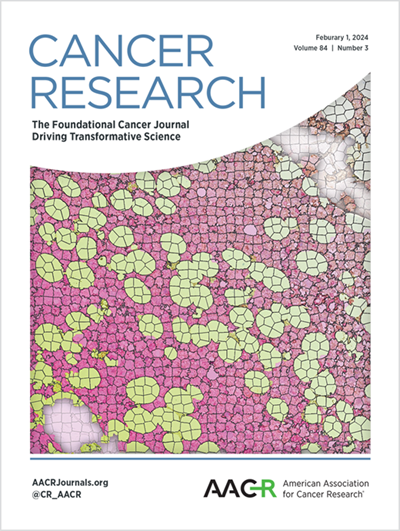Conditional Activation of c-MYC in Distinct Catecholaminergic Cells Drives Development of Neuroblastoma or Somatostatinoma
IF 12.5
1区 医学
Q1 ONCOLOGY
引用次数: 0
Abstract
c-MYC is an important driver of high-risk neuroblastoma. A lack of c-MYC–driven genetically engineered mouse models (GEMM) has hampered the ability to better understand mechanisms of neuroblastoma oncogenesis and to develop effective therapies. Here, we showed that conditional c-MYC induction via Cre recombinase driven by a tyrosine hydroxylase (Th) promoter led to a preponderance of PDX1+ somatostatinoma, a type of pancreatic neuroendocrine tumor (PNET). However, c-MYC activation via an improved Cre recombinase driven by a dopamine β-hydroxylase (Dbh) promoter resulted in neuroblastoma development. The c-MYC murine neuroblastoma tumors recapitulated the pathologic and genetic features of human neuroblastoma and responded to anti-GD2 immunotherapy and DFMO, an FDA-approved inhibitor targeting the MYC transcriptional target ODC1. Thus, c-MYC overexpression results in different but related tumor types depending on the targeted cell. The GEMMs represent valuable tools for testing immunotherapies and targeted therapies for these diseases.c-MYC在不同儿茶酚胺能细胞中的条件性激活驱动神经母细胞瘤或体细胞脂肪瘤的发育
c-MYC是高危神经母细胞瘤的重要驱动因素。由于缺乏c-MYC驱动的基因工程小鼠模型(GEMM),人们无法更好地了解神经母细胞瘤的致癌机制,也无法开发出有效的疗法。在这里,我们发现,通过酪氨酸羟化酶(Th)启动子驱动的Cre重组酶进行条件性c-MYC诱导,会导致PDX1+体节细胞瘤(一种胰腺神经内分泌肿瘤(PNET))的发生。然而,通过多巴胺β-羟化酶(Dbh)启动子驱动的改良Cre重组酶激活c-MYC,则会导致神经母细胞瘤的发生。c-MYC小鼠神经母细胞瘤肿瘤再现了人类神经母细胞瘤的病理和遗传特征,并对抗GD2免疫疗法和DFMO(一种FDA批准的针对MYC转录靶标ODC1的抑制剂)有反应。因此,c-MYC 过表达会导致不同但相关的肿瘤类型,具体取决于靶细胞。GEMMs是测试针对这些疾病的免疫疗法和靶向疗法的宝贵工具。
本文章由计算机程序翻译,如有差异,请以英文原文为准。
求助全文
约1分钟内获得全文
求助全文
来源期刊

Cancer research
医学-肿瘤学
CiteScore
16.10
自引率
0.90%
发文量
7677
审稿时长
2.5 months
期刊介绍:
Cancer Research, published by the American Association for Cancer Research (AACR), is a journal that focuses on impactful original studies, reviews, and opinion pieces relevant to the broad cancer research community. Manuscripts that present conceptual or technological advances leading to insights into cancer biology are particularly sought after. The journal also places emphasis on convergence science, which involves bridging multiple distinct areas of cancer research.
With primary subsections including Cancer Biology, Cancer Immunology, Cancer Metabolism and Molecular Mechanisms, Translational Cancer Biology, Cancer Landscapes, and Convergence Science, Cancer Research has a comprehensive scope. It is published twice a month and has one volume per year, with a print ISSN of 0008-5472 and an online ISSN of 1538-7445.
Cancer Research is abstracted and/or indexed in various databases and platforms, including BIOSIS Previews (R) Database, MEDLINE, Current Contents/Life Sciences, Current Contents/Clinical Medicine, Science Citation Index, Scopus, and Web of Science.
 求助内容:
求助内容: 应助结果提醒方式:
应助结果提醒方式:


